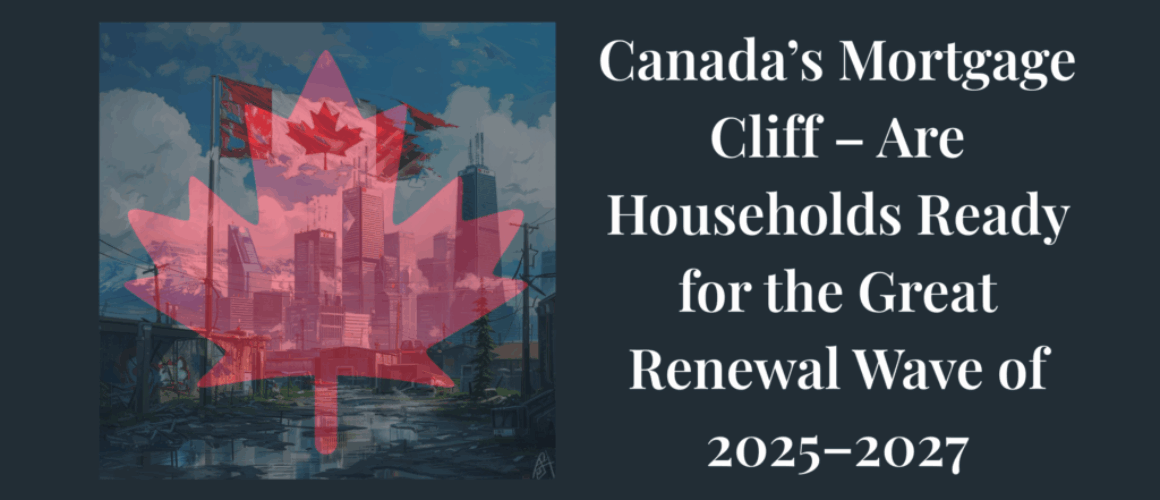Canada’s Mortgage Cliff – Are Households Ready for the Great Renewal Wave of 2025–2027?
Over the next 24 months, nearly 47% of Canadian mortgages are scheduled for renewal. For many homeowners, this transition won’t just be a line on a bank statement — it will be a financial reckoning. Rates that were locked in at historic lows during the 2020-2021 pandemic period are now maturing into a reality shaped by persistent inflation, higher interest rates, and declining real wage growth.
This upcoming “mortgage cliff” has already become a focal point for economists, policymakers, and financial planners. And while some Canadians are preparing for the transition, a significant portion remain under-informed, under-saved, and financially exposed.
The Numbers Behind the Shock
During the pandemic, the Bank of Canada slashed interest rates to just 0.25%, prompting a home-buying frenzy fueled by variable-rate mortgages and five-year fixed terms with rates under 2%. Today, those same borrowers are facing renewal offers at rates between 5.2% and 6.1%, depending on credit score and amortization choices.
For a household that borrowed $600,000 at 1.8% in 2020, monthly payments could jump by $1,000 to $1,200 at renewal — a 40% to 50% increase in housing costs. In urban centers like Vancouver and Toronto, where average mortgages easily exceed $700,000, the pain could be sharper.
A recent RBC analysis found that 29% of mortgage holders would face affordability stress without major lifestyle changes, additional income, or debt consolidation.
Variable-Rate Vulnerabilities
Variable-rate mortgage holders are feeling the pressure first. Many are already hitting their “trigger rate” — the point at which monthly payments no longer cover interest, let alone principal. In some cases, banks have extended amortization periods to 60 or even 70 years to avoid defaults, but this only postpones the problem.
Homeowners in this position are facing a tough decision: renew at a fixed rate and lock in higher payments, or continue variable exposure with the hope that rates will drop — a risky gamble if inflation rebounds or the Bank of Canada tightens again.
Government and Industry Response
The federal government has taken notice. Finance Minister François-Philippe Champagne has initiated a review of lender stress test rules and floated the idea of introducing a temporary mortgage relief tax credit for households whose interest payments exceed a defined percentage of net income.
Banks, too, are adapting. BMO and CIBC have launched “renewal resilience” outreach campaigns, offering personalized pre-renewal assessments, blended-rate options, and access to financial advisors specializing in debt restructuring.
But critics argue this is not enough. Advocacy groups like the Canadian Mortgage Federation are calling for a national registry of high-risk mortgages and mandatory pre-renewal financial literacy modules — especially for first-time buyers.
The Wealth Gap Widens
While middle-income households struggle with rising mortgage costs, wealthier Canadians are reaping the benefits of higher interest on savings, diversified portfolios, and cash-flow flexibility. This dynamic is widening the wealth divide, as lower-income groups dedicate more of their paycheck to housing while higher-income families build equity and passive returns.
Real estate investors, flush with equity and liquidity, are also preparing to scoop up distressed properties that may hit the market — further consolidating property ownership into fewer hands.
“We’re moving into an era where housing no longer guarantees wealth. It now tests financial literacy and market timing,” says Dr. Sanya Ried, a behavioral economist at Western University.
A Test of Resilience
The next two years will serve as a litmus test for Canada’s financial system and its citizens’ financial literacy. Will lenders act in good faith? Will borrowers adapt in time? Will policymakers step in with meaningful protections before defaults rise?
One thing is certain: the mortgage renewal wave is no longer on the horizon — it’s here. And how Canada handles it could define the financial well-being of millions for the next decade.
